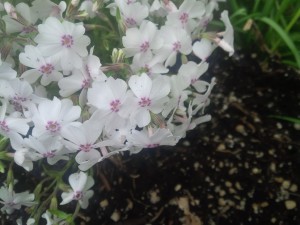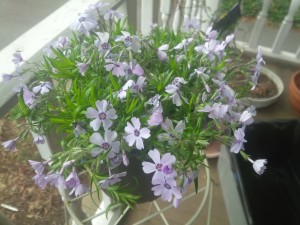
Last week I described the wonders of the Biltmore Estate gardens in Asheville, North Carolina. Both formal and naturalized areas are glorious, with beautifully cultivated and maintained landscapes full of specimen trees, shrubs, perennials and annuals. I am quite sure that the moment a petal drops in one of the formal areas; the petal is scooped up and composted. If two petals drop, the annual in question is replaced with a fresh one. Biltmore is, after all, a world-renowned tourist destination. Those tourists pay for and expect to see a certain standard of perfection. As far as I can tell, they will never be disappointed.
But there is much more to Asheville horticulture than Biltmore. The city of about 89,000 is home to a number of historic neighborhoods, each with its own distinctive character. The trait that links them all is gardens. From the smallest bungalow to the most ornate Queen Anne Victorian, a large number of Asheville homes boast colorful gardens.
Asheville is located in a valley surrounded by the Blue Ridge Mountains. The “valley” is far from flat, however, and the city is built on a series of rolling hills. Residential lots are often on uneven ground and many have front retaining walls of either stone or concrete. Residents evidently use the retaining walls as blank canvases. I have never seen so much creeping phlox–Phlox subulata–cascading over concrete in shades of pink, white, blue-purple and purple. After the phlox flowers fade, the evergreen foliage will remain, softening the walls’ edges in all four seasons. Alongside the phlox, I also saw quantities of white Aubrieta or arabis, another popular “cascade” plant. In my experience the lovely, spring-blooming Geranium x cantabrigiense ‘Biokovo’ will cascade in a polite manner and look good while doing it.
Many Asheville residents with dry-laid stone walls plant small specimens in the crevices. These also flow down the walls. This pocket-planting technique was used extensively by mid- twentieth century English gardening maven Margery Fish, author of the classic We Made a Garden. Mrs. Fish frequently tucked small, hardy geraniums in her crevices. In Asheville, wall gardeners insert additional phlox and forget-me-nots into the spaces between the stones. In my walls at home, I have found that violets work well too.
Suburban practitioners of Conventional Good Taste rarely trouble themselves with front gardens. They will cover their naked foundations with shrubs—preferably evergreens—to avoid offending the neighbors, and perhaps surround those shrubs with a narrow ribbon of annuals, changed out seasonally. Most CGT front lawns are uninterrupted by flower beds that might distract from the rolling waves of lawn grass.
In Asheville, the situation is different. Smaller front gardens, especially those in front of the many distinctive bungalows, may have little or no grass and a profusion of flowers, flowering shrubs and other ornamental plants. When I was there, Fothergilla, a shrub in the witch hazel family that bears white, bottlebrush-like flowers, was in bloom everywhere. We also saw a few of the hardier camellias. Late daffodils still bloomed and tulips were making an appearance. Virginia bluebells or Mertensia seemed quite happy in the North Carolina soil, as did Spanish bluebells—Hyacinthoides hispanica. Vertical spaces in large and small gardens were sometimes covered by wisteria, which was beginning its bloom cycle in mid April. The aptly nicknamed Carolina jessamine or Gelsemium sempervirons, a native plant with fragrant, yellow flowers, was blooming with wild abandon on arches and trellises.
Why the abundant front gardens? In many places the backyards appear to be small or difficult to cultivate because of steep slopes. On some lots, the sunny space may be in the front rather than in back. It might also be that Ashevilleans just like surrounding themselves with color. Their house paint choices often tend towards bright shades that are outside the typical northeasterner’s comfort zone, with lively accent colors on the trim or architectural features. The bed and breakfast where we stayed was a good example, painted vivid mustard yellow with red-orange trim. Needless to say it was ornamented with an inspiring, colorful garden.
Ashevilleans know that having a front garden is a little like wearing your heart on your sleeve. It takes courage, but makes for a more colorful life.
